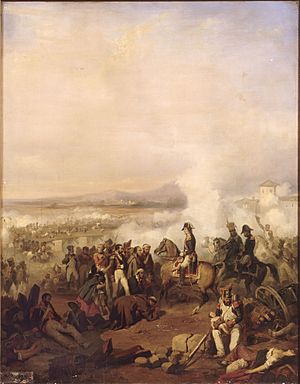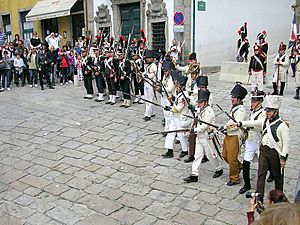First Battle of Porto facts for kids
Quick facts for kids First Battle of Porto |
|||||||
|---|---|---|---|---|---|---|---|
| Part of the Peninsular War | |||||||
 Marshall Soult surveys the broken bridge as Oporto falls to the French on 29 March 1809. In the foreground a grenadier rescues an orphaned baby. |
|||||||
|
|||||||
| Belligerents | |||||||
| Commanders and leaders | |||||||
| Strength | |||||||
| 30,000 | 16,000 | ||||||
| Casualties and losses | |||||||
| 8,000-10,000 killed Unknown wounded |
500 killed or wounded | ||||||
The First Battle of Porto happened on March 29, 1809. It was a big fight during the Peninsular War. French soldiers, led by Marshal Soult, fought against the Portuguese army. The Portuguese were led by General Parreiras. The battle took place just outside the city of Porto in Portugal. The French won this battle and then took control of Porto.
Contents
Background to the Conflict
The Peninsular War was a long conflict. It involved France fighting against Spain, Portugal, and the United Kingdom. This battle was part of the second time France tried to invade Portugal. Before this battle, there was another important fight called the Battle of Braga.
Soult's Invasion of Portugal
After a battle in Spain called the Battle of Corunna, the French leader Napoleon gave an order. He told Marshal Nicolas Soult to invade Portugal from the north. Soult was supposed to capture Porto by February 1st. Then he was to take Lisbon by February 10th. But Napoleon didn't realize how bad the roads were. He also didn't know about the strong guerrilla war that had started. This was a type of fighting where small groups of people attacked the larger army. It was happening all over Northern Portugal and Spain.
Marshal Soult's army was called the French II Corps. It had about 23,500 soldiers. This included 3,100 cavalry, who were soldiers on horseback. His army was made up of several divisions. Each division had many battalions of infantry (foot soldiers). They also had cavalry regiments.
Soult's first try to invade Portugal was stopped. Local Portuguese citizen soldiers, called militia, blocked him on February 16th. So, the French army changed direction. They moved northeast into Spain, to a place called Ourense. There, they found a bridge that wasn't guarded and crossed it. Then they marched south into Portugal.
On their way, French cavalry, led by General Franceschi, fought a Spanish group. This happened at La Trepa on March 6th. The French caused about 700 casualties to the Spanish. Casualties mean soldiers who were killed, wounded, or captured. The French then entered Portugal and took Chaves on March 9th.
From Chaves, Soult's army moved west. They went to a town called Póvoa de Lanhoso. There, they met a large Portuguese army. This army had about 25,000 men. Most of them were militia. They were armed with muskets, pikes, and even farm tools. Soult waited a few days for all his soldiers to arrive. Then, on March 20, 1809, he attacked.
This attack was the Battle of Braga. The experienced French soldiers easily defeated the Portuguese. The Portuguese lost about 4,000 killed and 400 captured. The French had much fewer losses, with 40 killed and 160 wounded. They also captured 17 Portuguese cannons.
The Battle for Porto
After the Battle of Braga, a leader named Bishop Castro organized an army. This army had about 24,000 men. Their goal was to defend the city of Porto.
The Portuguese army had about 4,500 regular soldiers. These were well-trained troops. They were supported by 10,000 ordenanças, who were local militia. Another 9,000 armed citizens also joined the defense.
Marshal Soult attacked the Portuguese defenses north of the city. This was the weakest part of the Portuguese line. Soult used several of his divisions in the attack. The Portuguese defense quickly broke apart. The battle became very difficult for the Portuguese.
Many Portuguese soldiers and citizens tried to escape into the city. But the French cavalry chased them through the streets. Many of the regular Portuguese units were completely defeated.
A terrible event happened during the escape. Thousands of people were trying to cross the Douro River. They were using a bridge made of boats. Some Portuguese units tried to damage the bridge to stop the French. But the bridge collapsed because of too many people on it. Also, Portuguese artillery from the other side of the river fired at the French cavalry. This fire also hit the bridge. Many fleeing civilians drowned in the river.
After the battle, the French captured many things. They took Spanish naval ships and 30 merchant ships. They also found large amounts of British military supplies. In the battle and the capture of the city, the French lost about 2,000 soldiers. The Portuguese lost around 8,000 people killed. The French also captured 197 Portuguese cannons.
Marshal Soult didn't get to enjoy his victory for long. Almost immediately, the local ordenanças cut off his communication lines with Spain. A group of 1,800 French soldiers was captured by a Portuguese force. This happened in the Siege of Chaves. Because of these problems, the French marshal started to plan his army's retreat.
Aftermath of the Battle
The second French invasion of Portugal continued after this battle. The next major event was the Battle of Grijó. Later, the city of Porto was taken back. This happened in the Second Battle of Porto. British and Portuguese forces, led by Wellesley, recaptured the city.
See also



